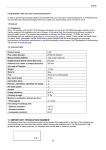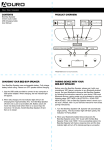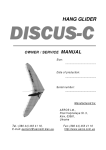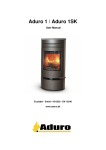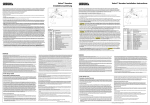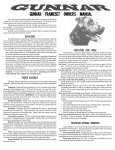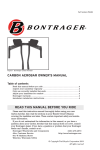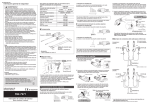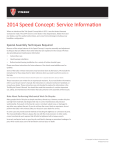Download Product Manual
Transcript
Manual Routing Di2 Frame Wires Down Tube E-wire • Remove the Battery Cover and Hidden Battery compartment from the frame and put aside (Figure 1). • Using electrical tape, attach the end of the Down Tube E-wire that connects to the Di2 Junction Box to a mechanical shifter cable. Feed the shift cable through the hole on the back vertical wall of the “cable bucket” until it exits the BB shell (Figure 2, Figure 3, Figure 4). TIP: The cable and E-Wire should remain above the ICS3 tubes within the frame. TIP: Use a screwdriver to push the zip ties through the hole, one by one. Lightly pull on the shift cable after inserting each zip tie (Figure 5). • Remove the electrical tape and mechanical shift cable from the E-wire. • Slide on the heat shrink tubing to the wire. Connect the wire to the color matched cable on the Di2 Junction Box, making sure to line up the cable properly (Figure 6). Front Derailleur E-wire • Insert the Front Derailleur E-wire into the cable hole on the seat tube (Figure 7, Figure 8). • Slide on the heat shrink tubing and connect the E-wire to the color matched cable on the Di2 Junction Box, making sure to line up the cable properly. Rear Derailleur E-wire • Using electrical tape, attach the end of the E-wire that connects to the Junction Box to a mechanical shifter cable. Feed the cable through the cable exit hole on the drive side chain stay, and out the BB shell (Figure 9). • Slide on the heat shrink tubing and connect the E-wire to the color matched port on the Di2 Junction Box (Figure 10). • Install the rubber Di2 grommet supplied with the frame, onto the cable exit hole on the drive side chain stay (Figure 11). Battery Mount • Feed the cable from the Di2 Battery Mount through the battery pocket in the rear wheel cutout and out the drive side of the BB shell (Figure 12). • Slide on the heat shrink tubing and connect the wire to the color matched cable on the Junction Box, making sure to line up the cable properly (Figure 13, Figure 14). • Mount the front derailleur on the frame and connect the E-wire (Figure 15). • Mount the rear derailleur on the frame and connect the E-wire (Figure 16). • Connect the battery, front wiring harness, and TT shifters. Test the Di2 system for proper function (Figure 17, Figure 18, Figure 19). • If the system does not work, double check all connections and ensure there is sufficient charge in the battery. If problems persist, please contact Shimano for further assistance (Figure 20). • If the system works properly, disconnect the front harness, shifters and battery. Set aside for the time being. 3T Aduro Aerobar Installation • Dry fit the fork, headset, basebar, and any spacers needed to determine the cut length of the fork steer tube based on the customer’s fit requirements. We strongly recommend a detailed measurement of the customer’s current bike to ensure proper fork cut length and fit (Figure 21). NOTE: The bearing cap is NOT needed when using the 3T Aduro bar. It is required with a traditional stem and aerobar combination. • Cut the fork and install the insert into the steer tube (Figure 22). • If spacers are being used, install one of the anti rotation spacer bolts into the front hole on the underside of the 3T Aduro bar (Figure 23). NOTE: If 10mm of spacers or more are required, the first spacer below the Aduro bar needs to be a 10mm spacer. A combination of two 5mm spacers should not be used together. If 10mm is needed, two 5mm spacers will not fit together properly, please use a 10mm spacer. • After placing the first spacer on the bar, install another anti rotation bolt. This process is continued until the last spacer is installed. The last spacer does not need an anti rotation bolt (Figure 24). • Attach the fairing mount to either the bottom spacer or directly to the aerobar if no spacers are required. • Mount the spacer(s), if necessary, and bar onto the fork steerer. Install the top cap and bolt to ensure the system pulls together properly. Torque the Aduro steerer tube pinch bolts to 5Nm (Figure 25). Magura Brake Installation Magura Front Brake Lever Installation using the 3T Aduro Aerobar • Remove the front brake cover from the brake. This is done with no tools, as the cover snaps onto the brake arm (Figure 26). TIP: It is easiest to remove the brake cover by grasping the cover from the back edge, and gently pulling away from the caliper. • Remove the hydraulic hose from the caliper (NOT THE LEVER) using an 8mm open ended wrench and place the caliper aside. Do not squeeze the caliper brake arms nor the brake lever as mineral oil will escape (Figure 27, Figure 28). • Using the Magura hose cutter (or a sharp knife on a hard surface) cut the hose just above the olive. Remove the threaded nut and set aside with the caliper (Figure 29, Figure 30, Figure 31). • Put a slight bend in the end of the hydraulic hose and feed it through the bar (Figure 32, Figure 33, Figure 34). • Install the lever into the bar and pull the hydraulic hose to ensure the lever is tight. • Using a 2mm Allen wrench, tighten the retention screw on either side of the lever blade to lock the lever in place (Figure 35, Figure 36, Figure 37). • Feed the end of the hydraulic hose through the bar, any spacers, and the fairing mount. Once installed, lightly pull on the hose to remove any slack (Figure 38). NOTE: Be careful not to kink the hydraulic hose during this step. Magura Rear Brake Lever Installation using the 3T Aduro Aerobar • Remove the hydraulic hose from the caliper (NOT THE LEVER) using an 8mm open ended wrench and place the caliper aside. Do not squeeze the caliper brake arms nor the brake lever as mineral oil will escape (Figure 27, Figure 28). • Using the Magura hose cutter (or a sharp knife on a hard surface) cut the hose just above the olive. Remove the threaded nut and set aside with the caliper (Figure 29, Figure 30, Figure 31). • Put a slight bend in the end of the hydraulic hose and feed it through the bar (Figure 32, Figure 33, Figure 34). • Install the lever into the bar and pull the hydraulic hose to ensure the lever is tight. • Using a 2mm Allen wrench, tighten the retention screw on either side of the lever blade to lock the lever in place (Figure 35, Figure 36, Figure 37). • Feed the hose through the back part of the aero bar and down through the middle hole in the bottom of the cable bucket (Figure 39). • The hose should feed through the down tube and out through the cable guide hole on the bottom of the BB shell (Figure 40). Magura Brake Lever Installation using the 3T Aura Pro Aerobar • Using an 8mm open ended wrench, remove the hydraulic hose from the caliper. Do not remove the hydraulic hose from the brake lever (Figure 27, Figure 28). NOTE: do not squeeze the caliper brake arms or brake lever, mineral oil will escape. • Using the Magura hose cutter (or a sharp knife on a hard surface) cut the hose just above the olive. Remove the threaded nut and set aside with the caliper (Figure 29, Figure 30, Figure 31). • Put a slight bend in the end of the hydraulic hose for easier routing through the basebar. • Slide a brake ferrule onto a mechanical shifter cable (Figure 41, Figure 42). • Feed the ferrule and cable into the underside of the Aura Pro bar and out the corresponding exit for the front or rear brake lever (Figure 43, Figure 44). • Install the ferrule onto the cut end of the hydraulic hose (Figure 45, Figure 46). • Push the hydraulic hose through the bar while lightly pulling on the shifter cable (Figure 47). • Continue until you just see the ferrule begin to exit the bar. • Pull on the shifter cable with a slight downward motion, while continuing to push on the hose, to help guide the ferrule and hydraulic hose out of the bar (Figure 48). • Install the lever into the bar and pull the hydraulic hose to ensure the lever is tight (Figure 49). • Using a 2mm Allen wrench, tighten the retention screw on either side of the lever blade to lock the lever in place (Figure 36, Figure 37). • Repeat the same process for the other lever. Magura Front Brake Caliper Installation • Cut the hydraulic hose 1-2mm above the center of the brake mount hole on the fork crown (Figure 50, Figure 51, Figure 52). • Slide the threaded nut on the hose. • Slide the new black olive (included with the brakes) on the hose (Figure 53, Figure 54). • Insert the hose back into the caliper and ensure it bottoms out (Figure 55, Figure 56). • Tighten the threaded nut (ensuring not to cross thread) until the olive begins to deform. Then turn the nut another half turn (Figure 57, Figure 58). • Using the 2mm washer and long brake nut, install the brake on the fork (Figure 59, Figure 60). Magura Rear Brake Caliper Installation • Remove the slack from the hydraulic hose, leaving roughly a 5mm gap between the hose and the top cap (Figure 61). • Cut the hydraulic hose 1-2mm in front of the brake mount hole on the BB shell (Figure 62, Figure 63). • Slide the threaded nut on the hose. • Slide the new black olive (included with the brakes) on the hose (Figure 64). • Insert the hose back into the caliper and ensure it bottoms out (Figure 65). • Tighten the threaded nut (ensuring not to cross thread) until the olive begins to deform. Then turn the nut another half turn (Figure 66). • Guide the hose through the slot in the BB cable guide and attach the guide to the frame (Figure 67, Figure 68, Figure 69). • Using the 2mm washer and short brake nut, install the brake onto the frame (Figure 70, Figure 71). 3T Aduro Aerobar Di2 Front Wiring Harness Installation NOTE: Front Wiring Harness instructions are the same for both high and low mounts. • Connect the Front Wiring Harness to the Down Tube E-wire. Each Front Wiring Harness has 4 wires, 2 for each left and right side. The 2 wires of each side are meant to be used with Di2 bar-end shifter and the Di2 shifter/brake lever on the base bar. With Magura brakes, only the longer wires, to reach the Di2 bar-end shifters, will be used. Di2 basebar shifting at the Magura brake lever is not possible with the current system (Figure 72). • The longer, red-coded cable is used for the rear shifter and the longer, white-coded cable is used for the front shifter. • Route the cables through the high mount and out the corresponding extension exit (Figure 73). • Stuff all the extra cables into the bar as you attach the high mount to the base bar (Figure 74, Figure 75). TIP: The extra cables can be taped together easier to stuff them into the Aduro bar. NOTE: The control box can be stuffed into the basebar, or as seen in the photo, left out for easy access. If left out of the bar, the control box can be attached to the stem using strong double-sided tape (Figure 76). • Grease the threads on the extension mount and thread on the collet nuts (Figure 77, Figure 78). • Route the shifter wire through the extension and out the access hole just beyond the bend in the extension. Repeat the process for the other extension. NOTE: the extensions may need to be trimmed in order to achieve the proper fit for the rider (Figure 79). • Install the bar end shifter pods as per Shimano assembly instructions (Figure 80, Figure 81, Figure 82). • Use an adjustable wrench to tighten the collet nuts to secure the extensions. The nuts should be tightened until the extensions no longer rotate (Figure 83). TIP: Use a clean rag between the adjustable wrench and the nut will prevent any cosmetic damage to the nuts. Arm Pad Installation • Install the bridge mount below the elbow rests. Each elbow rest should be lined up with the desired bolt-hole and attached to the bar using the proper bolts (Figure 84, Figure 85). • When using the high mount, insert the plastic plugs into the mounting holes on the base bar (Figure 86, Figure 87). Beard Installation • Slide the beard onto the fairing mount and attach using the 3 x M3 bolts provided with the fairing mount (Figure 87). Final Di2 Installation Steps • Ensure proper connection and function of all Di2 components. • Carefully heat-shrink all four Di2 Junction Box connections (Figure 88). • Stuff all the connections into the down tube making sure the BB area is clear for installation of the BB (Figure 89). • Attach the adhesive foam strip to the bottom of the battery compartment. • If the battery compartment sleeve does not have a notch in the corner, one can easily be cut with a retractable knife (Figure 90, Figure 91). • Place the Di2 battery into the compartment sleeve and slide it into the frame (Figure 92). • Install the bottom screw to secure the compartment in place (Figure 93). • Install the battery cover and secure it to the frame with the screw provided (Figure 94). • Bleed both front and rear brakes as per Magura’s bleeding instructions. • Using a 2.5mm Allen wrench, attach the rear brake cover using the 3 screws already installed in the frame (Figure 95). • Snap the front brake cover back on the arms of the brake caliper (Figure 26, Figure 96). • Ensure that all wires are clear of the BB opening and install the BB. • Proceed with normal assembly procedure for a bicycle. Additional P5 Assembly Information Rear Dropout Adjustment Screws • The position of the wheel can be adjusted using the pre-installed dropout adjustment screws. • The screws are adjusted using a 3mm Allen wrench. P5 Seatpost Head • Friction paste comes with all P5 seatposts. • Use of the friction paste is required on all mating surfaces of the seatpost head, or slippage will occur. Travelling with a P5 • Remove the front brake from the fork. The removal of the front brake cover is not necessary. • Loosen the stem pinch bolts with a 4mm Allen wrench • Remove the high mount or the top cover if using the low mount of the 3T Aduro Aerobar. • Remove the top cap and drop the fork out of the frame. • Remove headset parts and place aside. • Remove the beard from the fairing mount. • Remove the rear derailleur, leaving the e-wire connected. • Lay the bike frame & fork into the case. • Put protective padding between the frame and the aerobar to prevent damage during transportation. • Wrap protective padding around exposed parts of the frame, rear derailleur, crankset, and fork to prevent transportation damage. • Place any loose parts (headset, bolts, etc) in a small bag. It is advisable to secure the small parts bag so it doesn’t move around and cause potential damage. • Cover the frame and components with foam or other sufficient padding. • Remove the skewers from the wheels and attach them to the spokes. • Cover the frame and components with foam or other sufficient padding. • Tighten down the straps and put the cover on the case. Figure 1 Figure 2 Figure 3 Figure 4 Figure 5 Figure 6 Figure 7 Figure 8 Figure 9 Figure 10 Figure 11 Figure 12 Figure 13 Figure 14 Figure 15 Figure 16 Figure 17 Figure 18 Figure 19 Figure 20 Figure 21 Figure 22 Figure 23 Figure 24 Figure 25 Figure 26 Figure 27 Figure 28 Figure 29 Figure 30 Figure 31 Figure 32 Figure 33 Figure 34 Figure 35 Figure 36 Figure 37 Figure 38 Figure 39 Figure 40 Figure 41 Figure 42 Figure 43 Figure 44 Figure 45 Figure 46 Figure 47 Figure 48 Figure 49 Figure 50 Figure 51 Figure 52 Figure 53 Figure 54 Figure 55 Figure 56 Figure 57 Figure 58 Figure 59 Figure 60 Figure 61 Figure 62 Figure 63 Figure 64 Figure 65 Figure 66 Figure 67 Figure 68 Figure 69 Figure 70 Figure 71 Figure 72 Figure 73 Figure 74 Figure 75 Figure 76 Figure 77 Figure 78 Figure 79 Figure 80 Figure 81 Figure 82 Figure 83 Figure 84 Figure 85 Figure 86 Figure 87 Figure 88 Figure 89 Figure 90 Figure 91 Figure 92 Figure 93 Figure 94 Figure 95 Figure 96























